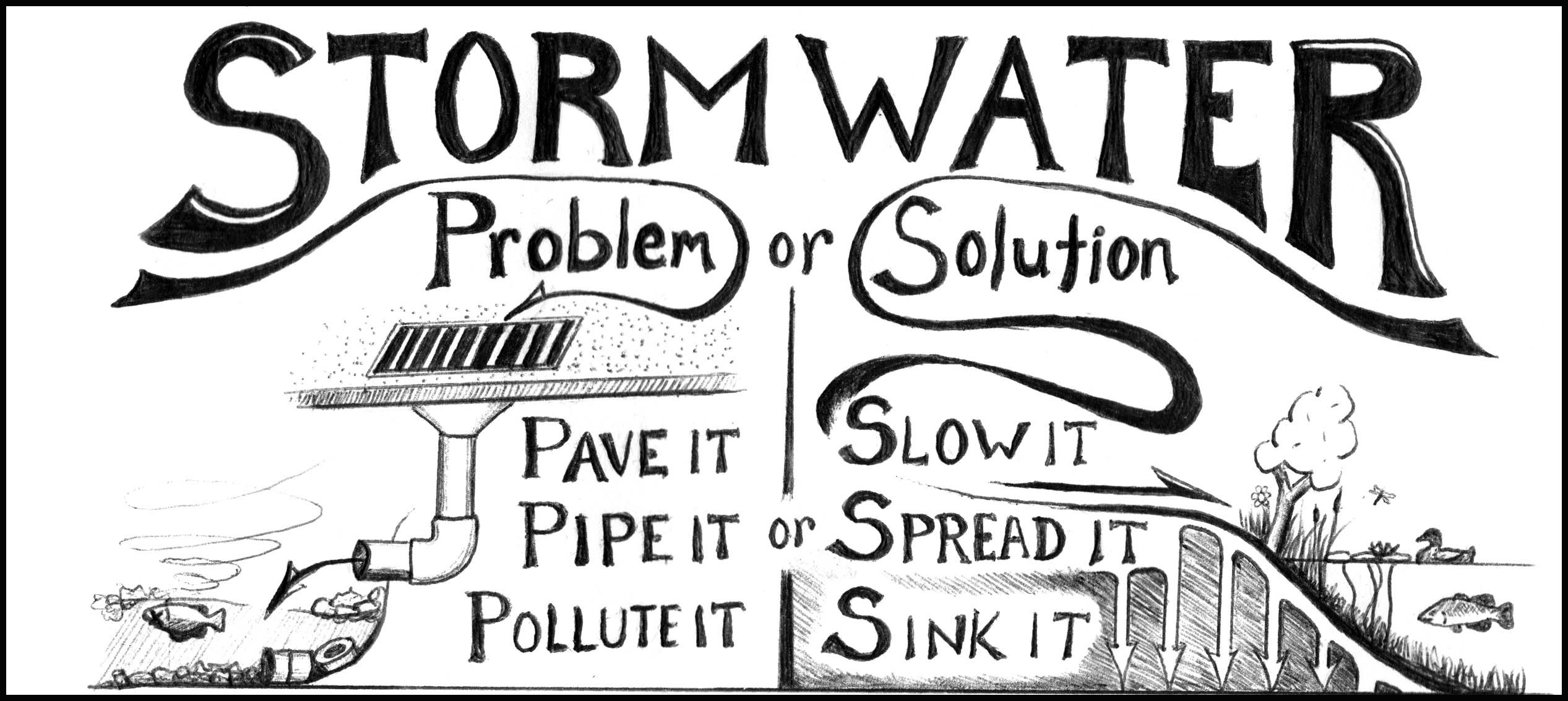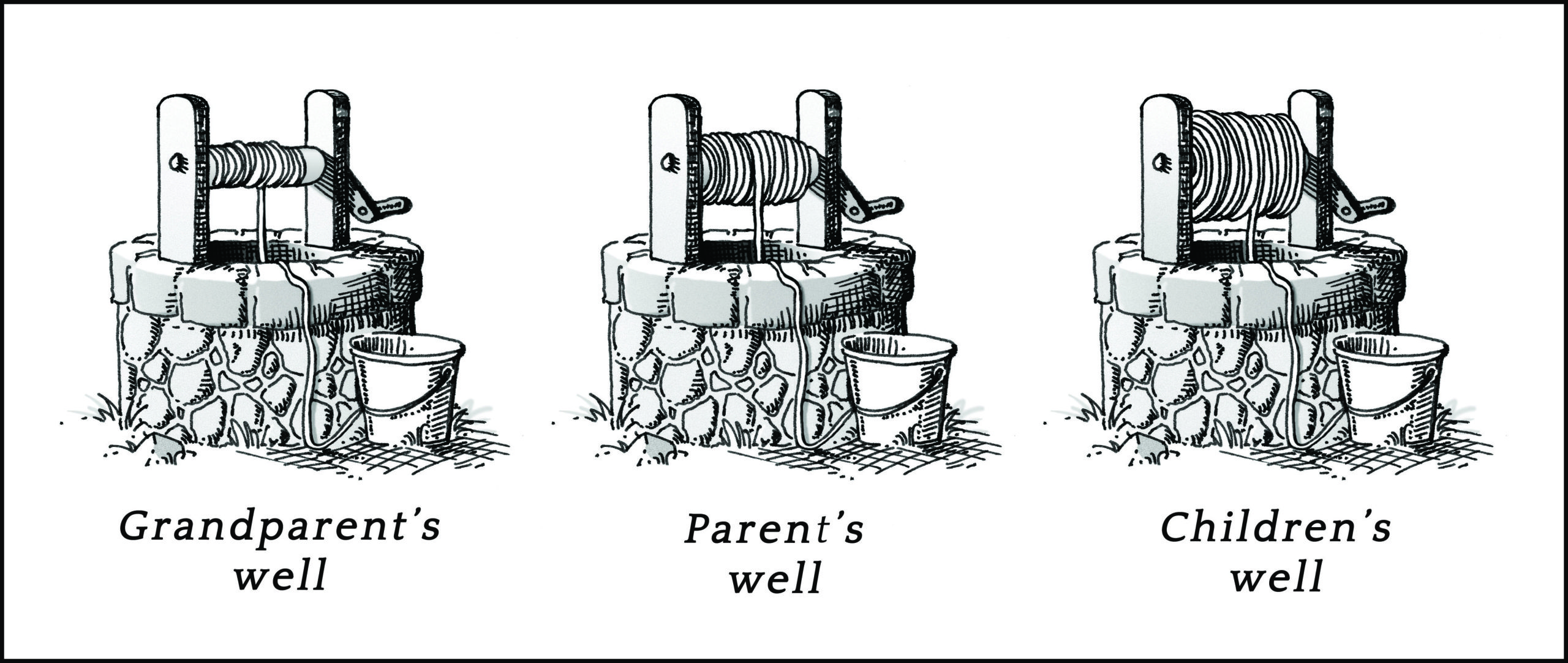At the OAEC WATER Institute, we call our philosophical and practical responses to the water challenges and opportunities before us “Conservation Hydrology.” Conservation Hydrology utilizes the disciplines of ecology, population biology, biogeography, economics, anthropology, philosophy, planning, and history to guide community-based watershed literacy, planning, and action. Conservation Hydrology advocates that human development decisions must move from a “dehydration model” to a “rehydration model.” To achieve this goal, we must retrofit existing development patterns with new ones based on the following principles.
Slow It, Spread It, Sink It! Store It! Spread It!
“The old drain-age is now being replaced by a new retain-age.”

Water is the ultimate resource. Thankfully, the Clean Water Act now recognizes the “pave and pipe paradigm” as disastrously flawed and hydro-illiterate. These outmoded engineering practices capture, concentrate, and convey water away from a site as quickly as possible. The old drain-age is now being replaced by a new retain-age.
The WATER Institute advocates a new paradigm of stormwater management based on “waterspread” restoration, with a call to slow it, spread it, sink it, store it, spread it: Slow the water down. Spread the water out. Sink the water into the land. Store water in the aquifer. Share the water with all of life.
Practical waterspread applications, such as bio-swales, raingardens, and stuffed gullies, serve to biologically filter stormwater, enhancing water quality. These applications can also enhance water quantity by optimizing groundwater recharge and reducing peak flood flows. If you live in a flood plain, these ideas may be more challenging to implement. You will need to evaluate the slope stability, soil porosity, storm event size, and run-off volumes of your site to determine which of these concepts is appropriate. When we learn to think like a watershed, we can transform development practices that will protect water quality and quantity.

IS YOUR WATER BUDGET BALANCED?
The 4 R’s of Conservation Hydrology: Receive, Recharge, Retain, and Release
The goals of Conservation Hydrology can be expressed in terms of sound budget management. The 4 R’s of a water budget are equivalent to income, deposit, savings, and expense. We want the water balance of our watersheds to run in the blue and not in the red. We want to ensure that our liquid assets continually produce a high-quality return on investment back into our Basins of Relations.
Receive = Income
- Watersheds only receive water as snowfall, rainfall, and fogfall. Annual precipitation is the only true source of income to replenish our community’s water budget allowance.
- Global climate changes are predicted to dramatically alter the frequency, intensity, and type of precipitation events that watersheds can expect to receive.
- Conservation Hydrology advocates the adaptive management of watershed lands to optimize rehydration. We must implement and enforce land use patterns that enhance the receptive capacity of our watersheds in times of excess and in times of scarcity.
Recharge = Deposit
- Recharge processes are critical for the water cycle to annually refresh itself via the deposit slip called infiltration. The capacity to make water deposits depends on the watershed’s recharge potential. Precipitation received by our watershed must percolate and be absorbed, or else there is no replenishment of our water savings account.
- Recharge potential and functions are impaired by the hardening and paving over of natural recharge areas, the disconnection of rivers from their floodplains, the deforestation of native vegetation, and the draining of wetlands.
- To increase recharge, we must limit impervious surfaces and the wholesale conversion of native vegetation. We must implement stormwater techniques designed to slow it, spread it, and sink it as a deposit into the Earth. We must protect open space in known groundwater recharge areas. If site conditions are not conducive to recharge, then we must ensure proper bio-filtration of all surface waters prior to their discharge and deposit into rivers, wetlands, lakes, estuaries, and oceans.
Retain = Savings
- The retention of recharged precipitation is a savings account asset. The storage of water is often the most challenging aspect of water supply management. Conservation Hydrology strategies should appropriately slow water down, increasing the residence time of water storage in our watersheds. This will optimize the amount of water available for local expense by living processes.
- We must avoid overdrafting and dewatering of our watersheds. Water should never be extracted from storage in amounts greater than what is annually received and recharged. All sources of water must not be polluted by development, wastewater systems, agricultural runoff, and industrial effluent.
- We must develop water budgets for all watersheds to ensure that extractions of water do not exceed inputs of water. We must implement groundwater and surface water management programs. We must ensure that surface and groundwater quantity and quality protection programs are funded, monitored and enforced. We must establish the public ownership of water as a public trust resource and resist the privatization of water.
Release = Expense
- Planet Water utilizes many ways to release its signature element naturally to the ocean, land, and atmosphere in a process known as the water cycle. Through seasonally melting glaciers, groundwater springs and seeps, water is returned to creeks and rivers. Solar evaporation and the evapotranspiration of plants help to form new clouds and feed the cycle anew. The infinite nature of this cycle is to continually flow and be in flux, as the expense of one stage produces income for the next.
- Human development practices (creating impervious surfaces, channelizing stormwater, etc.) tend to increase the rate and volume of stormwater’s return to the ocean via excessive runoff and heightened flood discharges. This directly reduces the landscape’s ability to retain water and diminishes the amount of water available for later release during the dry season, when it is most needed.
- The implementation of watershed-scale Conservation Hydrology practices will protect reception, amplify recharge, and thus optimize retention. These are the critical steps that can ensure optimal amounts of cold water will be available for future release.





